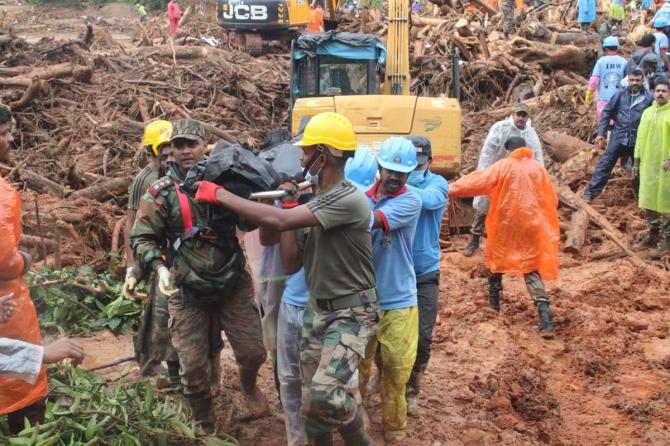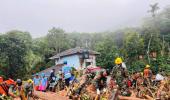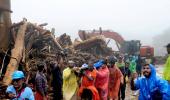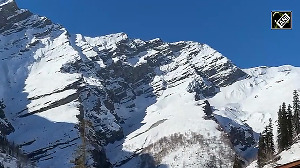'The larger story of systematic destruction, which can and has been quantified, goes mysteriously missing from any political and/or public discourse about the ongoing devastation in the Ghats,' notes Prem Panicker.

"It is not nature that kills, it is what we do to nature that kills us."
In all the years of knowing my friend Arati Kumar-Rao, I've lost count of the number of times I have heard her say this, on stage and off.
Nature, she consistently argues, can be nurturing if you learn Her ways and study how to live with Her; the reverse side of that coin is that if you do things that impact Nature without understanding what you are doing and what the effects will be, she will turn unbelievably violent. (If her award-winning book Marginlands -- which I cannot recommend highly enough -- has a central theme, it is encapsulated in that one line.)
Over the past two days of following the catastrophe still unfolding in Wayanad, those words kept coming back to me, because what we are witnessing is, at least in part, the downstream impact of what we have perpetrated elsewhere.
While spending a large part of yesterday evening and most of the night fielding calls from cousins who are part of the rescue efforts and transmitting their requirements to those in a position to help, I thought back to a field trip Arati and I had taken in 2019.
For the most part, we were walking the Kerala coastline as part of a recce, and we were bemused by what we say.
It's like that Dorothy Parker line: When you get there, there is no there, there.
Kovalam beach, a constant trope in 'God's own country' travel ads, does not exist, nor does neighbouring Shankhumugam.
Kerala's coastline, from before Vizhinjam as you come down from Kanyakumari all the way to Kollam and even beyond, is one long seawall, punctuated by occasional patches of sand.

Arati has written about the causes and the devastating impact of erosion in the 'Eating Up The Coast' chapter of Marginlands, so I won't go into that here.
What struck us then, and what made us want to revisit the land again, is a fundamental question: To build all these sea walls takes thousands of tons of rock. Where is it coming from?
Simple: The Western Ghats. And that is only the beginning of the problem.
In February 2023, ISRO released its Landslide Atlas. (external link) Wayanad district ranked 13th in the list of landslide prone areas, out of a total of 147 districts countrywide.
A statistic is worth noting: In 2014, ISRO recorded nine landslides in Kerala during the monsoon season.
In 2017, ISRO recorded 45 landslides during the same season. (A Scroll story from August 2023 cites even more startling figures (external link): In Kerala, ISRO recorded nine landslides in 2014, and 45 in 2017. In 2018, that number shot up to 5,181.)
What caused this escalation? Even as bodies are still being recovered from the ruins of what were once two towns, the blame game is in overdrive.
One BJP MP blamed encroachments by Muslims. The Union home minister said in Parliament that the loss of lives was because the state government had not heeded the warnings issued by his ministry seven days before the catastrophe.
No such warning was ever issued; the first time the Met department warned of intense rain with the possibility of landslides was the morning after the landslide had already occurred.
The Hume Centre for Ecology, based in Kalpetta, Wayanad, however had issued a warning (external link) of possible landslides, some 15 hours before the devastation began.
Various others have blamed the state government for ignoring warning signs and permitting unbridled construction in what is an ecologically sensitive region.

In 2020, the State Disaster Management Authority advised relocation of 4,000 families from the landslide-prone areas in Wayanad. Mundakkai was among these areas.
Several such articles have appeared over the last two days, pinning the blame on various factors.
There are trace elements of truth in all of those, but I'll leave that lie for now -- an ongoing catastrophe is no time for a detailed post-mortem.
I'll get back to this later, once the rescue operations are completed, or terminated, plus I have a trip through that region coming up around 17 August, which is an opportunity to gather more information. (In passing, word from the ground is that the sub-200 official toll is nowhere close to reality -- north of 700 is the estimate I'm getting from people on the ground.)
My intent here is to zoom out to a bigger picture, a part of which Arati and I had witnessed at first hand during our field trip.
In August 2015, the then Congress government gave formal permission to Adani Ports and SEZ to build a deepwater port in Vizhinjam, in Trivandrum district.
To build the port, the group had to first create a breakwater -- which is, a wall extending into the sea over 3.18 km.
To do that takes rock -- millions of tons of rock. Guess where the rock comes from?
The mining of rock from the Western Ghats region for this project came up before the National Green Tribunal, in 2019.
In its affidavit to the court, AVPPL (Adani Vizhinjam Port Private Limited) submitted (external link) that it needed 130 lakh metric tons of rock (see #39 in the affidavit) for the construction of the breakwater. It said that 55 lakh MT of that amount still needed to be mined.
Inference, 75 lakh MT had already been mined between 2015 and 2019.
AVPPL argued (see #38) that there is both a distinction and a difference between its mining operations and that of companies engaged in general quarrying.
The crux of its argument was that it was not using the mined rock for commercial profiteering. 'Therefore, a balance needs to be struck between the protection of environment and Sustainable Development,' it said.
Shorn of verbiage, the argument is simply this: What we are doing is 'development', what the other fellows are doing is environmental damage.
The argument that there is no commercial element in AVPPL's quarrying operations is specious.

In August 2019, the group received permission (external link) for 19 rock quarries (additional to the permits it had earlier acquired and begun mining from).
12 of these were to be operated directly by the group for construction of the seawall. The others were in partnership with private operators, with AVPPL getting 50% of the quarried stone, while the other 50% would be commercially exploited.
Note that this flies in the face of AVPPL's submission before the NGT that there would be no commercial exploitation of the mining licenses whatsoever.
Also worth noting is that in August 2019, when AVPPL received permission for additional quarries, the selfsame state government had issued a blanket ban (external link) on rock mining in the state.
Not that such bans are effective -- a headline statistic from this Mongabay piece (external link) says Kerala has a total of 5924 functioning stone quarries, though only 750 of these have obtained mandatory permission from the Department of Mining and Geology.
I am not suggesting that the rock mining, by AVPPL and others, is the proximate cause of the current catastrophe.
I am, however, saying that the massive mining of rock from the Western Ghats region has rendered an already unstable region even more prone to widespread destruction.
I'm also saying that governments -- state and Centre both -- cutting across political divides, in all of the seven states along the span of the Ghats, are complicit in the ongoing devastation of the highly sensitive ecology.
And I'm saying this now because we are yet again in the noise cycle, which runs thus: A disaster happens.
The media breathlessly reports the mounting toll, spiced with sob stories from survivors (I am not saying it shouldn't). Polity plays the blame-the-other-guy game.
Analysts pick on a visible symptom, rather than the underlying cause. And then we move on to the next story, and the next.
The larger story of systematic destruction, which can and has been quantified, goes mysteriously missing from any political and/or public discourse about the ongoing devastation in the Ghats.
Feature Presentation: Rajesh Alva/Rediff.com











 © 2025
© 2025